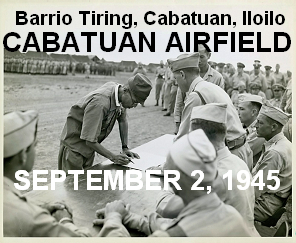
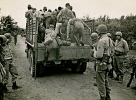

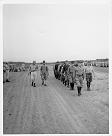


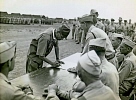
Col. Ryoichi Tozuka signs the surrender instrument
as Col. Raymond G. Stanton looks on.
Cabatuan Airfield
Barrio Tiring, Cabatuan, Iloilo
Panay Island, Philippines, September 2, 1945
|
|
- o -
|
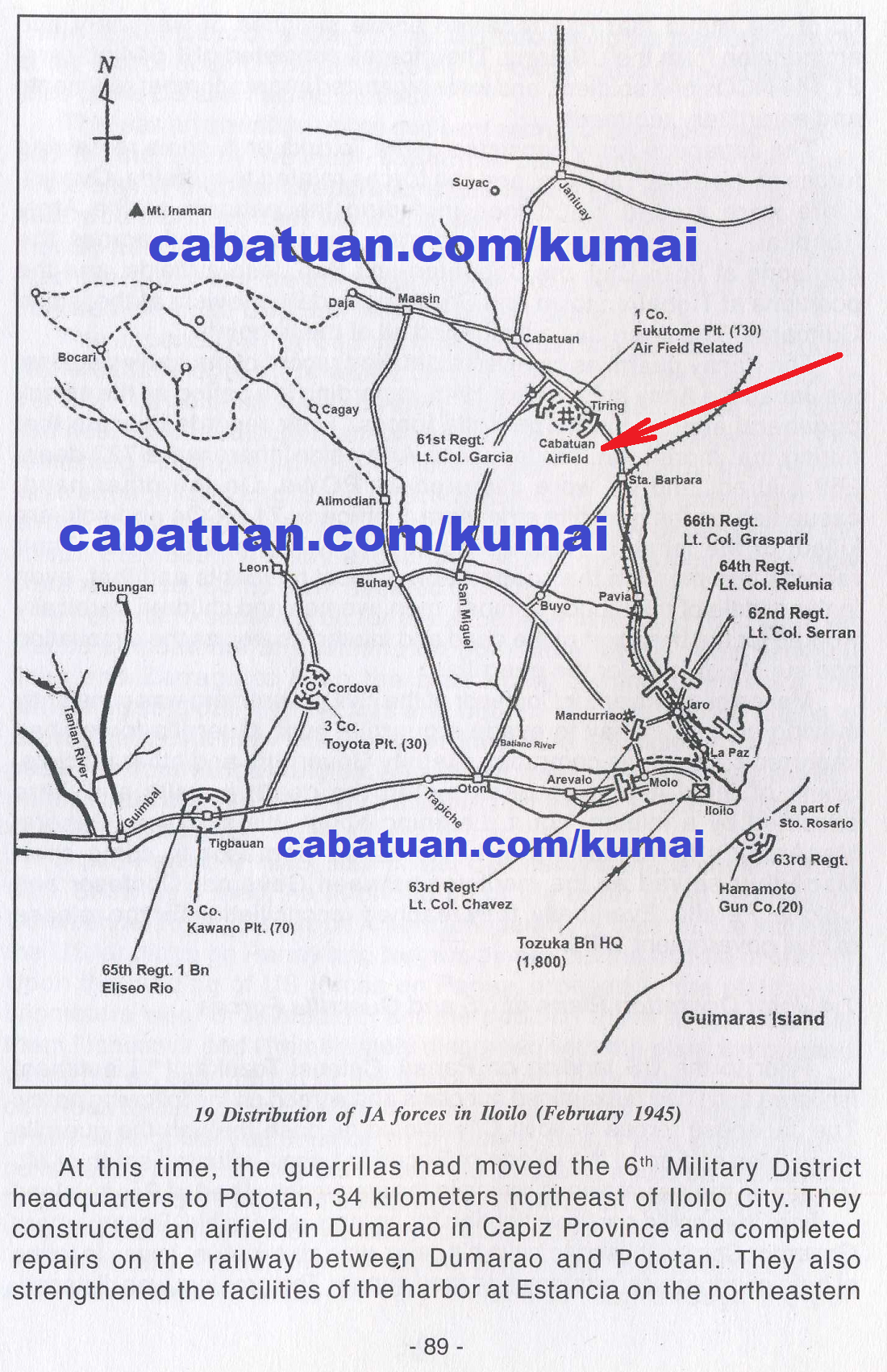
Distribution of JA forces in Iloilo (February 1945). Page 89.
|
|
7.3 General Attack of Guerrillas on Iloilo City
In early November 1944, Hôjin males under 45 years old were conscripted by the order of Manila headquarters to form a unit. I started training the troops gathered in Iloilo.
We did not have information about the movements of the US forces; but by around December 12, we received an emergency telegram informing us that a great transport fleet was moving west through the Surigao Strait under guard of a powerful task force of the US Navy. If they were to land on Panay, it was expected to be at around dawn of December 14.
Since we were led to believe that the battle in Leyte was still going on, no preparations had yet been made in Panay. Guerrillas had completely cordoned off Iloilo City and any urgent troop movement was impossible. Toward dusk that day, information about the fleet movement stopped coming in. Colonel Tozuka, 1st Lieutenant Ishikawa and I consulted and concluded that we should fight to the last man. Forces inside the city were ordered to get prepared. We could do nothing with only 2,000 aerial bombs. We all waited without sleep.
At around 2 p.m. on December 14, a kamikaze pilot made an emergency landing in Panay due to problems with his aircraft. He had seen the US fleet of several dozen ships going north along northwestern Panay. Given our forces at that time, if the enemy had landed on Panay, we had no other fate but to perish. On December 16, we heard on the radio from Japan that the US Forces had landed on Mindoro the previous day.
On Christmas Eve, the Lopez family invited Sergeant Matsuzaki and me. It must have been the worst Christmas for them. Knowing the obvious fate of the Japanese Army, I felt grateful for their kindness. On New Year’s Day of 1945, the Intendance Department gave one piece of rice cake (mochi) to everyone to celebrate the New Year. Actually, there was, no time to celebrate because of the guerrilla attacks. Around January 10, we learned from an American radio broadcast that US forces had landed at Lingayen Gulf in Luzon. The radio from Japan spoke of the good defense put up by the Japanese Army throughout Luzon, though their broadcast did not last long. We all felt worried and gloomy in the face of a rapidly deteriorating war situation.
With their attack on the Cabatuan airfield on February 1, the guerrillas started fierce attacks on other different places. On February 9, they launched a general attack on Iloilo City. At that time, a number of US officers were in command of the fighting of the guerrillas as military advisers.
The attacks happened at Molo, followed by those at the northern part of the city, behind the Japanese Army Hospital in La The Noda Company of the Tanabe unit at the Jaro garrison became isolated in this siege.
We quickly decided to form three companies, consisting of the Saitô weapons unit, two squads of the communications unit, the Labor Platoon, the Cadet unit of NCOs, and the Suzuki Transport Company. Captain Saitô commanded and Lieutenant lshikawa joined as instructor.
Towards the evening, after a fierce battle, the guerrillas withdrew. The brave charge that the NCO cadet platoon made through the bullets surprised the guerrillas and local residents. I learned this from the Lopezes when Sergeant Matsuzaki and I were invited to see them a few days later.
The guerrilla attacks were fierce on our positions at Molo, Jaro and La Paz. However, after February 9, they gave up trying to regain control of Iloilo City by themselves, and decided to wait for the US landing. Nevertheless, the Japanese garrisons continued to come under ferocious attacks. US air bombings and bombardment by the guerrillas became more relentless throughout Iloilo City.
Gradually, residents were evacuating to other places away from the city. Mr. Fernando Lopez repeatedly asked the permission of Colonel Tozuka to leave Iloilo City through Sergeant Matsuzaki. Finally, Lopez personally came over to headquarters to ask. Still, the Commander did not approve. Eventually the family disappeared; I felt it was better because their presence no longer made a difference to the whole situation, and I prayed for their safety.
At this time, the guerrillas had moved the 6th Military District : headquarters to Pototan, 34 kilometers northeast of Iloilo City. They constructed an airfield in Dumarao in Capiz Province and completed repairs on the railway between Dumarao and Pototan. They also strengthened the facilities of the harbor at Estancia on the northeastern tip of the island that had received ample supplies of weaponry and ammunition from the US Army. Their forces consisted of 1,544 officers, 21,144 NCOs and soldiers, and were organized into six combat regiments and an artillery regiment.
The Japanese Army consisted of the Tozuka unit, some remaining forces of the 102nd Division, and the forces related to airfields. Overall, there were around 2,500 men including the patients at the Army Hospital. The active officers and men were scattered across the garrisons at Iloilo City, the Cabatuan and San Jose airfields, and the positions at Tigbauan town and Cordova, and Buenavista at the island of Guimaras. The guerrillas surrounded all of these points.
The Panay guerrillas have left a detailed record of the battles against the Japanese Army in February 1945, regarding the period as the climax of general attacks by the guerrilla forces. Their records indicate that during that month, on the Japanese Army side, there were 723 dead, 269 injured, and 24 were captured as POWs. On the other hand, casualties on the guerrilla side were 8 officers, 71 NCOs and soldiers killed; of the injured, 10 officers and 147 NCOs and soldiers. Their records also mention the cooperation of local residents and that, even in the middle of the bloody combat, men, women and children heroically worked for the transport of the dead and injured as well as the evacuation and supply of food for the guerrillas.
Meanwhile, Governor Confesor of the civil government was constantly moving all over Panay to evade a guerrilla hunt. Guerrilla forces had captured some of his comrades, Deputy Governors and other officials. Some of them had even been meted the death penalty and were executed by a military court. Learning about this situation, General MacArthur’s headquarters in Leyte asked Confesor to come over. MacArthur served as the mediator between Governor Confesor and Colonel Peralta. Eventually, they reached reconciliation for the release of civil government VIPs.
|
|